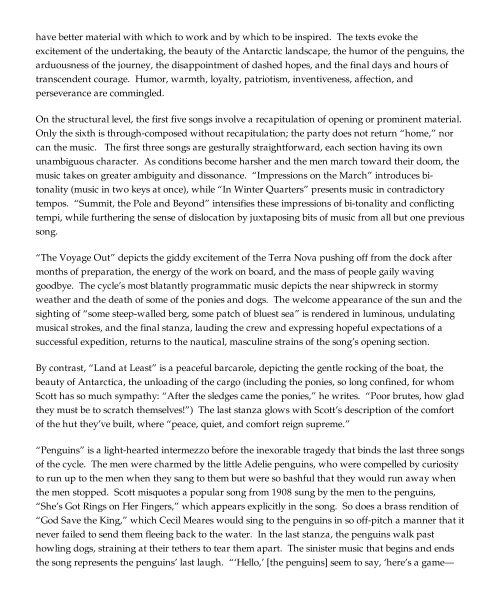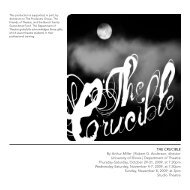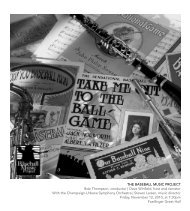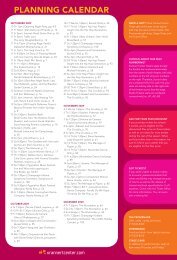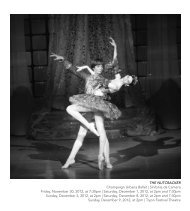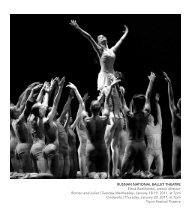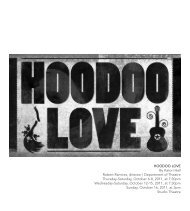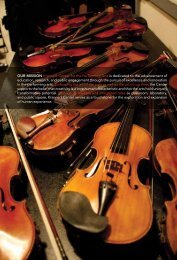Program - Krannert Center for the Performing Arts
Program - Krannert Center for the Performing Arts
Program - Krannert Center for the Performing Arts
Create successful ePaper yourself
Turn your PDF publications into a flip-book with our unique Google optimized e-Paper software.
have better material with which to work and by which to be inspired. The texts evoke <strong>the</strong>excitement of <strong>the</strong> undertaking, <strong>the</strong> beauty of <strong>the</strong> Antarctic landscape, <strong>the</strong> humor of <strong>the</strong> penguins, <strong>the</strong>arduousness of <strong>the</strong> journey, <strong>the</strong> disappointment of dashed hopes, and <strong>the</strong> final days and hours oftranscendent courage. Humor, warmth, loyalty, patriotism, inventiveness, affection, andperseverance are commingled.On <strong>the</strong> structural level, <strong>the</strong> first five songs involve a recapitulation of opening or prominent material.Only <strong>the</strong> sixth is through-composed without recapitulation; <strong>the</strong> party does not return “home,” norcan <strong>the</strong> music. The first three songs are gesturally straight<strong>for</strong>ward, each section having its ownunambiguous character. As conditions become harsher and <strong>the</strong> men march toward <strong>the</strong>ir doom, <strong>the</strong>music takes on greater ambiguity and dissonance. “Impressions on <strong>the</strong> March” introduces bitonality(music in two keys at once), while “In Winter Quarters” presents music in contradictorytempos. “Summit, <strong>the</strong> Pole and Beyond” intensifies <strong>the</strong>se impressions of bi-tonality and conflictingtempi, while fur<strong>the</strong>ring <strong>the</strong> sense of dislocation by juxtaposing bits of music from all but one previoussong.“The Voyage Out” depicts <strong>the</strong> giddy excitement of <strong>the</strong> Terra Nova pushing off from <strong>the</strong> dock aftermonths of preparation, <strong>the</strong> energy of <strong>the</strong> work on board, and <strong>the</strong> mass of people gaily wavinggoodbye. The cycle’s most blatantly programmatic music depicts <strong>the</strong> near shipwreck in stormywea<strong>the</strong>r and <strong>the</strong> death of some of <strong>the</strong> ponies and dogs. The welcome appearance of <strong>the</strong> sun and <strong>the</strong>sighting of “some steep-walled berg, some patch of bluest sea” is rendered in luminous, undulatingmusical strokes, and <strong>the</strong> final stanza, lauding <strong>the</strong> crew and expressing hopeful expectations of asuccessful expedition, returns to <strong>the</strong> nautical, masculine strains of <strong>the</strong> song’s opening section.By contrast, “Land at Least” is a peaceful barcarole, depicting <strong>the</strong> gentle rocking of <strong>the</strong> boat, <strong>the</strong>beauty of Antarctica, <strong>the</strong> unloading of <strong>the</strong> cargo (including <strong>the</strong> ponies, so long confined, <strong>for</strong> whomScott has so much sympathy: “After <strong>the</strong> sledges came <strong>the</strong> ponies,” he writes. “Poor brutes, how glad<strong>the</strong>y must be to scratch <strong>the</strong>mselves!”) The last stanza glows with Scott’s description of <strong>the</strong> com<strong>for</strong>tof <strong>the</strong> hut <strong>the</strong>y’ve built, where “peace, quiet, and com<strong>for</strong>t reign supreme.”“Penguins” is a light-hearted intermezzo be<strong>for</strong>e <strong>the</strong> inexorable tragedy that binds <strong>the</strong> last three songsof <strong>the</strong> cycle. The men were charmed by <strong>the</strong> little Adelie penguins, who were compelled by curiosityto run up to <strong>the</strong> men when <strong>the</strong>y sang to <strong>the</strong>m but were so bashful that <strong>the</strong>y would run away when<strong>the</strong> men stopped. Scott misquotes a popular song from 1908 sung by <strong>the</strong> men to <strong>the</strong> penguins,“She’s Got Rings on Her Fingers,” which appears explicitly in <strong>the</strong> song. So does a brass rendition of“God Save <strong>the</strong> King,” which Cecil Meares would sing to <strong>the</strong> penguins in so off-pitch a manner that itnever failed to send <strong>the</strong>m fleeing back to <strong>the</strong> water. In <strong>the</strong> last stanza, <strong>the</strong> penguins walk pasthowling dogs, straining at <strong>the</strong>ir te<strong>the</strong>rs to tear <strong>the</strong>m apart. The sinister music that begins and ends<strong>the</strong> song represents <strong>the</strong> penguins’ last laugh. “‘Hello,’ [<strong>the</strong> penguins] seem to say, ‘here’s a game—


